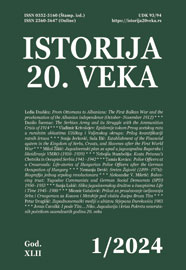EPIDEMIJE TOKOM PRVOG SVETSKOG RATA U RURALNIM OBLASTIMA UŽIČKOG I VALJEVSKOG OKRUGA: PRILOG KVANTIFIKACIJI RATNIH ŽRTAVA
EPIDEMICS DURING WORLD WAR I IN THE RURAL AREA OF VALJEVO AND UŽICE REGIONS : CONTRIBUTION TO QUANTIFICATION OF WAR VICTIMS
Author(s): Vladimir KrivošejevSubject(s): Military history, Political history, Social history, Health and medicine and law, Pre-WW I & WW I (1900 -1919)
Published by: Institut za savremenu istoriju, Beograd
Keywords: Serbia; Valjevo; Užice; World War I; epidemics; diseases; mortality; shortage of inhabitants;
Summary/Abstract: In the years that preceded the World War I, the inhabitants of the rural areas of the west of Serbia, in Valjevo and Užice regions, died of natural causes, because of various accidents and wide range of non-epidemic diseases, but mostly of the consequences of local epidemic of different infectious diseases, primarily of pertussis, and then of scarlet fever and dysentery, as well as diphtheria, stomach typhus and measles, and during Balkan War II, in 1913, of cholera. At the beginning of the World War I, the situation did not change a lot, but diphtheria became primary cause of the death. Besides, it was expected to notice murdering the soldiers at the front, but, also, two widespread epidemics on the territories appeared: three kinds of typhus epidemics, stomach, spotted fever and a reversible type during 1915 and Spanish fever during 1918. On the basis of the death registers, it is noticed that in 34 villages of the analysed rural area, where 21483 peasants lived, the death was registered among 4852 of them, i. e. 22.59% of the inhabitants registered before the war, from January of 1914 to December of 1918. It is also noticed that 8.77% died of typhus and Spanish fever (5.27% of typhus, and 3.50% of the Spanish fever), 4.42% of other infectious diseases, and 9.40% of all other possible causes. If we exclude from the analysis two great epidemics, 13.81% of the inhabitants died, during five year war period, of all causes including local epidemics, while in the prewar five year period, that was 12.95%. Regarding the fact that the results of the population census from 1910 and 1921, indicates that analysed territory had bigger demographic loss from the average for Serbia (18.47%:11.98%), it can be assumed Serbia lost about one fifth of the inhabitants during war years, from August of 1914 to November of 1918.
Journal: Istorija 20. veka
- Issue Year: 2024
- Issue No: 1
- Page Range: 45-64
- Page Count: 20
- Language: Serbian

